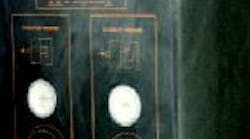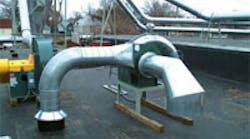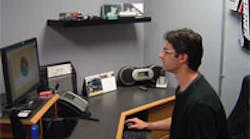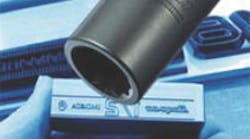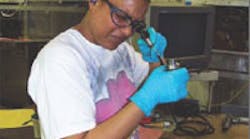A Mold-Vac air-evacuation system reduces part-reject rates and tool-steel wear and improves molding operations at Mid South, especially when the shop runs highly corrosive mold materials like PPS.
Airtex is a full-service supplier of custom fueldelivery systems and water pumps for OEMs, and Mid South Manufacturing of Marked Tree, Ariz., is one of its manufacturing and distribution centers. While discussing a proposed new job, a customer requested that Mid South install an air-evacuation system on the injection-molding machine intended for running the job's parts — mainly because the material used to mold the part was highly corrosive PPS.
Mid South sought air-evacuation-system quotes from vendors. Among them was CAE Services, a plastics-engineering consulting organization that suggested the Mold-Vac unit. The system reduced part-reject rates and tool-steel wear and improved molding operations.
"We have a lot of problems with PPS and the tool-steel wear it causes," explains Tommy Wilson, an injection-molding supervisor at Mid South. "With the Mold-Vac system, we generated more than one million shots during a particular job. After each production run, we disassembled the mold, cleaned all vents, and reassembled it. Subsequently, we have not spent any money on repairs to that mold."
Self-contained Mold-Vac systems eliminate trapped air and gas within mold cavities prior to and during injection cycles. The unit's blowback feature cleans and purges vented ejector and core pins after each cycle.
The Mold-Vac also solved a problem Mid South was having with molding a water pump. The system let the sonic-welding process used to produce the part completely fill the energy bead. "In addition," says Wilson, "if we didn't have the Mold-Vac, we would have experienced a tremendous amount of burns."
CAE Services
Batavia, Ill.
caeservices.com
Software shifts team into five-axis machining
The Proton KR motorcycle-racing team relies on PowerMill CAM software and five-axis machining for designing and manufacturing its own special racing bikes.
Unlike motorcycle racing teams that use bikes supplied by major manufacturers, Proton KR develops its own special designs at a facility outside Banbury, England. Relying on PowerMill CAM software, the team successfully accomplishes five-axis machining, which lets it keep more manufacturing work in-house, gives designers more freedom, and enables most of the bike's components to be machined from solid material instead of fabricated from parts.
Andy Stokes, programmer and machine operator at Proton KR, admits it took a little time to take full advantage of the shop's new DMU 50 eVolution five-axis machine from DMG. "With five-axis machining, jobs have to be looked at a bit differently," he explains. "We need to adjust approaches to fixturing and workholding for accessing the maximum number of features in each setup."
The shop produces frame components from solid materials using five-axis machining and wire EDM. This provides increased structural integrity at low weights as compared with fabricated parts. With such methods, the team reduces bike weight by more than 30 lb.
Also, machined components are consistent, according to Stokes. Previously, the shop had to grind new parts to make them fit. Now, spare parts from the shelf mount accurately on the bike without alterations.
In addition, the team uses PowerMill and the DMG machine for R&D work. "We machine many different port designs into engines to obtain optimum performance," says Stokes, "and PowerMill provides the flexibility needed for such work."
Delcam Inc.
Windsor, Ont.
delcam.com
Shop sends out scanning work
Instead of its in-house CMM, GE Transportation relies on laser-scanning services provided by Laser Design.
General Electric (GE) Transportation switched from a coordinate measuring machine (CMM) to laser scanning for inspecting aftermarket components for diesel engines and reduced the process time by 50%. However, due to its relatively small number of such parts needing scanned yearly, the company decided against purchasing a laser scanner and, instead, uses a service bureau offering laser-scanning inspection. The laser scanner at Laser Design Inc. quickly measures GE Transportation's large parts while generating greater numbers of data points than touch probes, and it requires no fixtures or templates. The system replicates complex part geometries often to within 0.001 in., and models can be superimposed upon original-design geometries for determining where they differ. In addition, lasers are noncontact, which eliminates problems such as depressing soft objects and measuring small cavities.
Inspecting parts on a CMM at GE Transportation was timeconsuming because operators had to manually move the machine probe into position for each point to be measured.
Also, as part complexity increased, so too did the amount of points needed to characterize their geometries. Operators spent several weeks generating points onebyone and were never sure that they hadn't missed a critical feature.
According to Mark Frederick, engineering leader for GE Transportation, Laser Design delivers accurate CAD models quickly. To illustrate, he cites the company's most complicated part, an air-duct assembly.
For this part, Laser Design scanned and generated a point cloud in which each point was accurate to within 20 µ, and surfaces generated from it were held to at least 0.004 in. (mainly because of the part's large size).
"The entire project cost $3,000 and took less than a month. This wouldn't have been the case if we did it ourselves on the CMM," comments Frederick.
Using a CMM, GE Transportation operators captured and converted points into dimensions and then manually created a solid model with the points as a skeleton. For a part as complicated as the air-duct assembly, the process took two to three months and cost between $6,000 and $9,000.
Laser Design
Minneapolis
laserdesign.com
Shop opts for new ERP
At machine shop AT Precision in Northbrook, Ill., an enterprise resource planning (ERP) system is critical to successful business. That's why, when its first system failed to meet expectations, the company incorporated a new one that converts and uses the company's current information, is easy to learn, and integrates data with the shop's website.
The system is M1 ERP, and it includes production modules such as contact, order, job, inventory, purchasing, shipping, and labor management; scheduling; and security. There are other modules for estimating and quoting, call and lead management, point of sale, product configuration, advanced bill-of-materials, and more.
Converting data from the old to the new system took less than an hour, according to Chuck Thudium, president of AT Precision. And he says that M1 provides completely usable data, including the ability to search for any data component. It also offers customization and the power to search in dozens of different ways under every conceivable criterion.
Because M1 looked and felt like and integrated with familiar Microsoft products such as Word, Excel, and Outlook, AT Precision employees were using it within hours and without formal training. "The shop-floor-entry modules that feed information back to the office are solid and let employees easily punch in and out and enter information on current jobs they are working on," explains Thudium. "Thus, we can track jobs in real time."
To give customers real-time information, M1's data integrates with AT Precision's website. Customers access their accounts to check order status or outstanding balances, review quotes, obtain delivery information, and track shipments. "Offering these abilities is an important selling point for our company," adds Thudium.
AT Precision's first system did not perform all these needed functions and had several bugs. For example, it did not allow for customization, so employees had to carefully enter information in a set format to permit later searches. And difficulties escalated during software updates. When one function was updated, another stopped working, and eventually each upgrade meant starting from scratch with the entire system. The result was lost productivity as days were spent straightening out or re-inputting corrupt information.
Bowen & Groves
Irvine, Calif.
bowen-groves.com
Accuracy drives cutting machine
GF Goodman & Son's downstream cutting machines sport faster I/O and servo-loop update-response times and more control over operating parameters with FlexDrive digital servo drives.
GF Goodman & Son, a manufacturer of downstream cutting machines, wanted to improve the accuracy of its plastic-tube-cutting machines without major redesign. Cutting accuracy depends primarily on drive response because the machine's knife must cut at a constant rate and stop as repeatably as possible without overshooting.
To get this needed accuracy, the Ivyland, Pa., company contacted Baldor Electric, which suggested its FlexDrive digital servo drives.
Compared to the earlier servos used on Goodman's cutting machines, FlexDrives offer faster I/O and servo-loop update-response times and considerably more control over operating parameters such as stiffness, dither, and overshoot. The system's software also features autotuning wizards and a Windowsbased graphical user interface that minimize setup time, while an oscilloscope facility provides instant visual feedback on tuning parameter changes. The system slashed machine response time from 200 to 100 µs.
Goodman's customers, which manufacture cut-to-length products, work at precise dimensions to reduce material waste and maximize profit. Even small cutting-machine errors, over time, add up to significant amounts of waste, so cutting accuracies of ±0.020 in. are not unheard of.
Says Duke Davis, managing director of GF Goodman, "As a result of the Baldor project, we have doubled cutting accuracy, to the obvious benefit of our customers, and because the upgrade was cost effective and simple, we are now incorporating FlexDrives across our range of high-speed cutto-length machines."
Baldor Electric Co.
Fort Smith, Ark.
baldor.com
CNC retrofit lifts machine productivity
A retrofitted Siemens Sinumeric 810D CNC boosts overall machine productivity 11% for Eaton Corp.'s Heald grinder.
Dressing and grinding spindles on Eaton's Heald grinder run at high rpm and are controlled by a retrofitted Sinumeric 810D CNC.
A key machine tool at Eaton Corp.'s facility in Roxboro, N.C., is a Heald 1VL I.D. grinder for finishing the company's automotive hydraulic lifters and associated components. Unfortunately, the machine's control, an early generation Siemens 3G CNC, was showing signs of wear and causing maintenance problems and downtime. After evaluating available controls, as well as the machine's main frame and other mechanical components onboard, Eaton decided to retrofit the grinder with a Siemens Sinumeric 810D CNC that boosted its overall productivity 11%.
Eaton collaborated with Ex-Cell-O Machine Tools Inc. of Sterling Heights, Mich., on the retrofit. Ex-Cell-O managed the controls integration, machine software, interface design, electricals, and implementation of the new system. Eaton handled the mechanical aspects of the project. Both companies agreed on the Sinumeric 810D because of its compact size, digital-axis drives, HMI interface, custom cycles, and imbedded PLC.
The PC-based control for simple to medium-range CNC applications features an integrated NC and PLC and handles up to six axes and two spindles. Its Simatic PLC consists of standard hardware and software components tailorable to individual tasks.
Ex-Cell-O used the existing program format to maintain operator compatibility with old programs, which were about 75% transportable, with modifications to areas requiring new functionality. This minimized operator impact with the new equipment since controls and program parameters were basically similar to the old equipment.
Special operator-interface screens match original parameter values to reduce extensive operator training. In addition, programmed fault and operator messages minimize
downtime and provide extensive information for operators and maintenance personnel.
Siemens Machine Tool Business
Elk Grove Village, Ill.
siemenscnc.com
